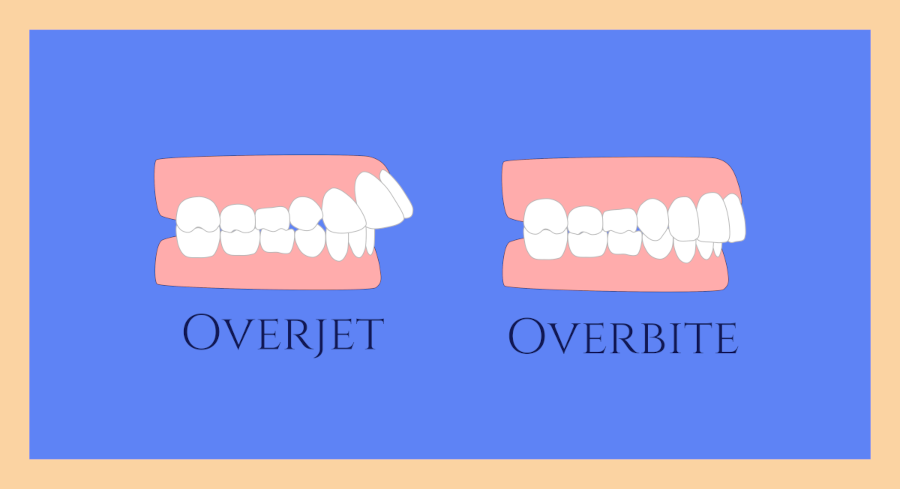

There is a lot of confusion as to the difference between overbite vs overjet. Truthfully, there are even a number of orthodontic office websites that also are confused as to the difference between the two. In this article, we discuss the differences between overbite and overjet, how they develop, the relationship between the two, and how they can be treated.
When patients first come into the office, they frequently mention that they have an "overbite" they would like corrected. The first question Dr. Skarin will ask at the initial appointment is for them to define "overbite" so that everyone is on the same page. Nine times out of ten, patients say overbite but what they are really describing is "overjet"! Let's look at the definitions of the two terms and how they relate:
To be clear, normal overbite would have the upper incisors vertically overlapping the lower incisors by 1-2 millimeters when the individual is biting with their posterior teeth completely together. Most of the height of the lower incisors should be easily seen from the front!
Normal overjet would find the upper and lower incisors in contact, with the upper incisors ahead of the lower incisors by the thickness of the edge of the upper incisors, by about 2-3 millimeters.
Most of the time, prospective patients are concerned about overjet, where the upper teeth are well in front of the lower teeth. There are problems associated with this excessive protrusion of the teeth, but potentially far more serious problems can occur when overbite is allowed to continue developing. Before we proceed to discuss overbite and the multiple problems associated with it, let's look at overjet/protrusion of the teeth.
Every normal bite needs overjet. The upper anterior teeth should rest their incisal third on the incisal edges of the lower anterior teeth when biting down. If the upper anterior teeth are further forward than that, then overjet becomes excessive.
The two most common problems are :
Correcting overjet problems is relatively easy unless a deep overbite is present. As long as there is excessive horizontal space between the upper anterior teeth and the lower anterior teeth and there is excess arch length/spaces in the upper posterior teeth, the upper anterior teeth can be retracted or pulled back to a normal overbite/overjet relationship.
You may have noticed a reference was made that overbite can continue to develop or worsen with time. Overbite develops when the upper anterior teeth are not in contact with the mandibular teeth during normal function. When teeth are not in contact with one another, teeth will continue to erupt. For example, if a person loses a posterior tooth for whatever reason, the tooth opposing the lost tooth will, over time, erupt vertically into that space, changing the level of the arch it is part of. This vertical change can often be significant, sometimes half the vertical height of the crown of the tooth that is erupting. This is a slow, insidious, painless process that usually goes unnoticed until significant problems develop. This very same movement will occur when the upper anterior teeth are well forward of the lower front teeth and do not touch one another. Unless there is some tongue habit, such as a tongue thrust, reverse swallow or digital habit, the lower front teeth will erupt upward toward the upper arch of teeth and palate and the upper front teeth will erupt downward toward the lower lip.
As mentioned and explained earlier, correction of overjet by itself is pretty straight forward and can be done in some cases with a removable appliance, certainly with braces and probably aligners as well. But adding to the deep overbite problem, depending on its severity and skeletal growth vector, can take from months to years and could require a large number of appliances applied at different stages of treatment with significant attention to long-term (life-time) maintenance to keep relapse from occurring. Certain procedures and appliances can be employed, if appropriate and needed, to open up a deep bite or impinging overbite.
Palatal expansion, if a skeletal crossbite is present, will help open a deep bite. Headgear set up in certain ways to help correct a skeletal prognathia, as explained earlier, can also help open the bite. Removable appliances started early to utilize passive eruption of the posterior teeth can help significantly. Some of the European functional appliances developed in the last century have been shown to help in the mixed dentition. Placing acrylic on the top/occlusal surfaces of molars or bonded turbo blocks placed on the inside surfaces of the upper anterior teeth to artificially open the bite in order to place braces on the lower arch are additional techniques. And fixed appliances/braces are essential to apply needed intrusive/ extrusive forces on certain teeth.
However, the most important variable in knowing how difficult and how long the treatment will go is based on a patient's growth pattern. Your orthodontist will be able to show you through a cephalometric evaluation and multiple analyses based upon over a century of growth data whether the treatment will be slightly difficult but manageable in a normal treatment time, or exceedingly difficult taking far longer than normal with the possibility of some damage to the teeth through the needed forces that must work against the periodontal structure that is in place to naturally prevent against the movements needed to correct the problem. If you think this type of bite can be difficult to treat to an acceptble result, then you are correct.
It is highly recommended that you visit an A.A.O. accredited orthodontist in your area to get a thorough evaluation of your overbite problem as it is not a treatment that just aligning the teeth will fix. You can visit the American Association of Orthodontists to find an accredited orthodontist near you or give us a call to schedule a complimentary consultation.
4 N Washington St.
Naperville, IL 60540
630-369-0045
803 N Bridge St.
Yorkville, IL 60560
630-553-5227